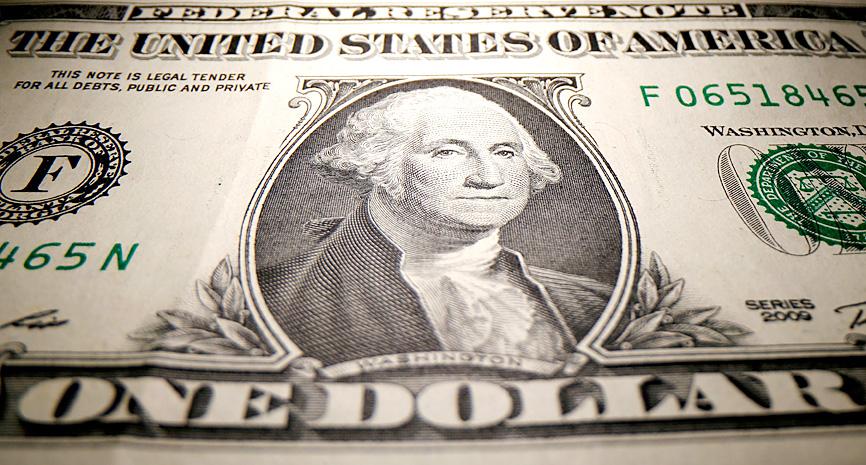The US dollar on Friday consolidated gains and posted its biggest weekly rise in seven months as markets priced in a year ahead of aggressive hikes in US interest rates.
Money markets priced in a 28.5 basis-point interest rate hike in March last year and as many as 119.5 basis points in cumulative increases by year’s end as the US dollar steadily rose in a week highlighted by a more hawkish tone from the US Federal Reserve.
The US dollar index rose a scant 0.04 percent to 97.22. The index, which measures the US dollar’s value against other major currencies, rose 1.65 percent for the week, its biggest weekly gain since June. It shot above 97 for the first time since July 2020.

Photo: Reuters
“I look for some consolidation, but nothing to say that the dollar’s up move is over,” Bannockburn Global Forex chief market strategist Marc Chandler said.
US labor costs increased in the fourth quarter, but less than expected, the US Department of Labor said.
The Employment Cost Index (ECI), the broadest measure of labor costs, rose 1.0 percent after increasing 1.3 percent a quarter earlier.
Economists polled by Reuters had forecast a 1.2 percent advance in the ECI, widely viewed as one of the better measures of labor market slack and a predictor of core inflation.
“The Employment Cost Index, which [Fed Chairman Jerome] Powell has referred to specifically, was a bit softer than expected, and has spurred some position adjusting ahead of the weekend,” Chandler said.
US Treasury yields eased, with 10-year yields falling to about 1.77 percent for the day, well below two-year highs of nearly 1.9 percent hit on Monday.
The two-year Treasury yield, which often moves in step with rate expectations, slid 2.8 basis points to 1.164 percent, but was still much higher for the week.
Major currencies drifted sideways in Asian trading before Lunar New Year holidays next week even though US yields were marginally higher.
The New Taiwan dollar declined against US dollar on Friday, losing NT$0.022 to close at NT$27.828, down 0.45 percent from NT$27.702 a week earlier.
However, the NT dollar soared 2.02 percent against the greenback in the Year of the Ox due to Taiwan’s robust export performance, the central bank said.
Friday was the last trading session for the year on the lunar calendar.
The euro nursed losses on Friday with the single currency little changed at US$1.1143, a bit up from Thursday’s 20-month low of US$1.1131.
The yen rose 0.14 percent to ¥115.21 per US dollar.
Additional reporting by CNA, with staff writer

SELL-OFF: Investors expect tariff-driven volatility as the local boarse reopens today, while analysts say government support and solid fundamentals would steady sentiment Local investors are bracing for a sharp market downturn today as the nation’s financial markets resume trading following a two-day closure for national holidays before the weekend, with sentiment rattled by US President Donald Trump’s sweeping tariff announcement. Trump’s unveiling of new “reciprocal tariffs” on Wednesday triggered a sell-off in global markets, with the FTSE Taiwan Index Futures — a benchmark for Taiwanese equities traded in Singapore — tumbling 9.2 percent over the past two sessions. Meanwhile, the American depositary receipts (ADRs) of Taiwan Semiconductor Manufacturing Co (TSMC, 台積電), the most heavily weighted stock on the TAIEX, plunged 13.8 percent in

A wave of stop-loss selling and panic selling hit Taiwan's stock market at its opening today, with the weighted index plunging 2,086 points — a drop of more than 9.7 percent — marking the largest intraday point and percentage loss on record. The index bottomed out at 19,212.02, while futures were locked limit-down, with more than 1,000 stocks hitting their daily drop limit. Three heavyweight stocks — Taiwan Semiconductor Manufacturing Co (TSMC, 台積電), Hon Hai Precision Industry Co (Foxconn, 鴻海精密) and MediaTek (聯發科) — hit their limit-down prices as soon as the market opened, falling to NT$848 (US$25.54), NT$138.5 and NT$1,295 respectively. TSMC's

TARIFFS: The global ‘panic atmosphere remains strong,’ and foreign investors have continued to sell their holdings since the start of the year, the Ministry of Finance said The government yesterday authorized the activation of its NT$500 billion (US$15.15 billion) National Stabilization Fund (NSF) to prop up the local stock market after two days of sharp falls in reaction to US President Donald Trump’s new import tariffs. The Ministry of Finance said in a statement after the market close that the steering committee of the fund had been given the go-ahead to intervene in the market to bolster Taiwanese shares in a time of crisis. The fund has been authorized to use its assets “to carry out market stabilization tasks as appropriate to maintain the stability of Taiwan’s

In a small town in Paraguay, a showdown is brewing between traditional producers of yerba mate, a bitter herbal tea popular across South America, and miners of a shinier treasure: gold. A rush for the precious metal is pitting mate growers and indigenous groups against the expanding operations of small-scale miners who, until recently, were their neighbors, not nemeses. “They [the miners] have destroyed everything... The canals, springs, swamps,” said Vidal Britez, president of the Yerba Mate Producers’ Association of the town of Paso Yobai, about 210km east of capital Asuncion. “You can see the pollution from the dead fish.